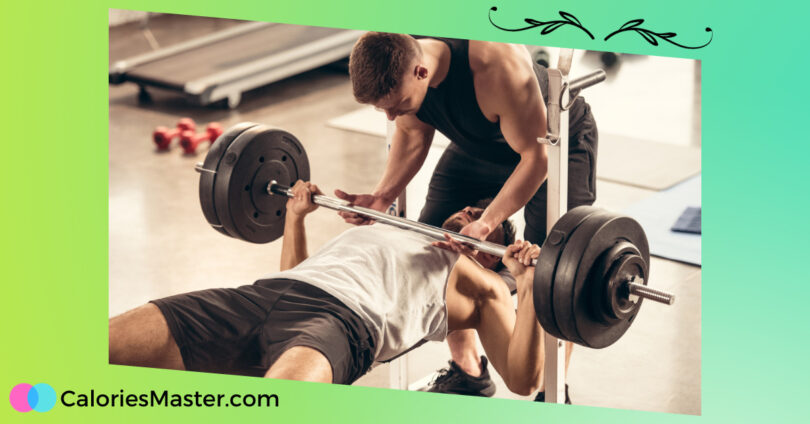Weight training has increasingly gained popularity among fitness enthusiasts and athletes, as it offers numerous benefits in addition to overall strength and muscle development.
A crucial aspect of effective weight training is working with a knowledgeable weight trainer who can guide one toward achieving their individual goals. In this article, we will discuss the importance of having a weight trainer, proper form, and the various types of resistance training methods.
A weight trainer is responsible for designing an individual’s exercise regime tailored to their specific needs, be it weight management, muscle toning, or improved athletic performance, whilst ensuring their safety.
Their expertise and guidance can significantly enhance one’s progress and results. Emphasizing the correct form during exercises is essential, as it not only prevents injury but also maximises the effectiveness of the workouts.
To make weight training varied and well-rounded, weight trainers utilise diverse resistance techniques like free weights, machines, and bodyweight exercises.
The choice of which resistance methods to incorporate in a training programme depends on factors such as the individual’s goals, fitness level, and available equipment.
By working with a skilled weight trainer, one can experience the many benefits of weight training while maintaining a safe and efficient routine.
The Role of Weight Trainer
A weight trainer, also known as a strength or resistance trainer, plays a significant role in a comprehensive fitness and weight loss plan. Here are several ways in which a weight trainer can contribute to your fitness and weight loss journey:
Understanding Your Health Goals
A weight trainer, also known as a personal trainer, plays an essential role in helping individuals achieve their health and fitness goals. These professionals are equipped with the knowledge to create tailored workouts for their clients, whether it be for weight loss, muscle building, or overall health improvement.
They can assess an individual’s current fitness levels and understand their needs better to create a programme that fits their abilities and aspirations.
A competent weight trainer will:
- Listen attentively to your concerns and motivations
- Assess your overall fitness and monitor your progress
- Guide on maintaining motivation and overcoming obstacles
Personalised Exercise Programs
A central aspect of a weight trainer’s role is to design personalised exercise programmes that suit the client’s needs. These programmes are tailored to:
- Help the client establish a regular workout routine
- Focus on specific muscle groups based on the client’s objectives
- Match the intensity level to the individual’s abilities
The weight trainer ensures that each exercise is executed in a manner that maximises its benefits while minimising the risk of injury. They also review and adjust the programme to keep track of the client’s progress and account for any potential changes in their goals or abilities.
To sum up, a weight trainer is responsible for understanding their clients’ health goals and designing personalised exercise plans that cater to their needs.
They are knowledgeable in proper workout techniques and help clients achieve their desired outcomes safely and efficiently. With their guidance, clients can work towards improved health and well-being.
The Types of Weight Training
There are various types of weight training, each targeting different aspects of muscular fitness. Here are some common types:
Strength Training
Strength training focuses on increasing muscle mass and power by using heavy weights with fewer repetitions. It often involves exercises targeting specific muscle groups, such as free weights like dumbbells or weight machines.
Some typical strength training exercises include squats, deadlifts, and bench presses. Strength training can also help improve bone density and metabolic rate.
Resistance Training
Resistance training involves working against an external force to challenge your muscles, such as resistance bands or your body weight. This type of weight training is versatile, allowing for a variety of exercises that can be performed anywhere.
Resistance training exercises include push-ups, pull-ups, and bicep curls with resistance bands. These exercises can help develop muscular endurance and functional fitness.
Circuit Training
Circuit training combines strength and resistance exercises, usually performed in a series of timed intervals. This type of training aims to improve overall fitness by challenging both aerobic and anaerobic capabilities.
In a typical circuit, you might perform a set of each exercise before moving on to the next, with minimal rest in between. Exercises may include a mix of free weights, machines, and resistance bands. Circuit training can help increase cardiovascular endurance, while also promoting muscle tone and weight loss.
Major Muscle Groups and Their Training
When engaging in weight training, it’s essential to target major muscle groups for balanced development and functional strength. Here are some major muscle groups and exercises associated with each:
Back and Shoulders
The back and shoulders are comprised of multiple muscle groups, including the latissimus dorsi (lats), trapezius (traps), and deltoids (delts). To effectively train these muscles, incorporate a variety of exercises like:
- Pull-ups: Target the lats and build strength
- Rows (bent over, seated): Engage both the lats and traps
- Shoulder press: Focus on the deltoids
Varying your grip and implementing repetition schemes can improve muscle growth and overall development.
Arms and Chest
The arms and chest contain the biceps, triceps, and pectoral muscles (pecs). To train these muscle groups, include exercises such as:
- Bicep curls: Target the biceps with dumbbells or a barbell
- Tricep dips: Focus on tricep development with parallel bars or a bench
- Bench press: Strengthen the chest muscles while also working the triceps
Remember to use proper form and increase resistance gradually to minimise the risk of injury.
Legs and Abdominals
Legs consist of quadriceps (quads), hamstrings, glutes, and calves. Abdominals encompass the rectus abdominis, obliques, and transversus abdominis. Train these muscles by incorporating:
- Squats: Engage quads, hamstrings, and glutes simultaneously
- Lunges: Work quads and hamstrings while also improving balance
- Leg press: Focus on quads with this machine-based exercise
- Calf raises: Develop calf muscles using body weight or added resistance
- Crunches: Target the rectus abdominis for a strong core
- Russian twists: Work the obliques and improve core stability
Ensure you maintain proper technique throughout all exercises to effectively target the appropriate muscle groups.
The Correct Form and Techniques
Performing weight training exercises with proper form and technique is crucial for maximizing effectiveness, preventing injuries, and targeting the intended muscle groups. Here are some general guidelines for maintaining the correct form:
Squat
The squat is a fundamental compound exercise that works for multiple muscle groups. To ensure proper form, follow these steps:
- Stand with feet shoulder-width apart and toes slightly pointed outwards.
- Engage your core and keep your chest up. Maintain a neutral spine.
- Lower your body by bending your knees and hips, as if sitting in a chair.
- Maintain a full range of motion by going down until your thighs are parallel to the floor.
- Push through your heels to return to the starting position.
Key points to remember when performing a squat include:
- Knee alignment: Make sure your knees stay in line with your toes as you lower and lift.
- Heel contact: Keep your heels flat on the floor throughout the movement.
Deadlift
The deadlift targets the lower back, glutes, and hamstrings. Use the following technique for safe execution:
- Stand with feet hip-width apart, barbell over midfoot, and toes pointing forward.
- Lower down, bending at the hips and knees while keeping a neutral spine.
- Grasp the bar with an overhand or mixed grip, just outside your knees.
- Ground your heels, engage your core, and maintain a flat back.
- Push through your heels and fully extend your hips and knees to lift the bar.
- Reverse the motion, lowering the barbell back to the floor.
Pay attention to these crucial aspects during the deadlift:
- Grip strength: Chalk, straps or a mixed grip can help with grip issues.
- Hip hinge: Initiate the lift from your hips, not your lower back.
Push-Up
The push-up engages the chest, triceps, and shoulders. Follow this procedure to perform the exercise with the correct form:
- Start in a plank position with hands about shoulder-width apart and fingers facing forward.
- Engage your core and glutes.
- Lower your body by bending your elbows, keeping them close to your body.
- Descend until your chest is just above the ground, achieving a full range of motion.
- Push through your hands to return to the plank position.
Common points to be mindful of when doing push-ups include:
- Lower back: Prevent your lower back from sagging by engaging your core.
- Elbow positioning: Avoid flaring your elbows out to the sides; aim for a 45-degree angle.
Safety Measures and Injury Prevention
Ensuring safety during weight training is crucial to prevent injuries and promote a sustainable fitness routine. Here are some safety measures and injury prevention tips for weight training:
Warmup
Warming up before any weight training session is crucial to minimise the risk of injuries. A proper warmup routine increases blood flow to the muscles, improving flexibility and preventing strain on the joints. Some effective warmup exercises include:
- Dynamic stretching: Perform movements like arm circles, leg swings, and side-to-side lunges to gently stretch muscles and joints.
- Cardiovascular exercises: Light jogging, cycling, or jumping jacks for 5-10 minutes help increase heart rate and blood flow to the muscles.
Incorporate movements targeting specific muscle groups you’ll be working on, such as the spine, elbows, and knees, to ensure they’re well-prepared for the weight training session.
Pain Management
During workouts, pay attention to any discomfort or pain in your body. If pain occurs, consider the following tips to manage it effectively:
- Modify the exercise: Adjust your form or technique to ensure proper alignment and reduce stress on the affected area. If pain persists, stop the exercise immediately.
- Apply ice packs: For acute pain or inflammation, apply an ice pack to the affected area for 15 minutes every hour.
- Rest: Give your body adequate time to recover by avoiding activities that aggravate the pain.
- Seek professional help: If pain persists despite implementing the above measures, consult a healthcare professional for advice and potential treatment.
Remember that consistent and gradual progression in your weight training is key to avoiding injuries and maintaining a healthy, strong body. Listen to your body and do not attempt to push through severe pain, as this may further exacerbate existing injuries or create new ones.
Diet and Metabolism
The relationship between diet and metabolism plays a crucial role in weight management. Understanding how calorie intake and a balanced diet impact metabolism aids in achieving fitness goals.
Calorie Intake
To maintain, lose, or gain weight, it is essential to monitor and adjust calorie intake. The number of calories needed varies based on age, sex, weight, and activity levels.
Consuming fewer calories than expended results in weight loss, while consuming more leads to weight gain. To maintain weight, balance calorie intake with expenditure.
Basal Metabolic Rate (BMR) is a measure of the energy expenditure at rest, accounting for 60-75% of total calorie burning. BMR differs according to factors such as age, weight, height, and muscle mass.
A Total Daily Energy Expenditure (TDEE) calculator can help estimate the ideal calorie intake based on individual BMR and activity level.
Importance of a Balanced Diet
A balanced diet provides essential nutrients and adequate energy to support metabolic functions, regulate appetite, and improve overall well-being. Key principles of a balanced diet include:
- Macronutrients: Essential for energy and bodily functions, macronutrients include carbohydrates, protein, and fats. Balancing these three components helps ensure the body receives the energy it needs to function effectively.
- Micronutrients: Vitamins and minerals that support various metabolic processes, such as enzyme functions and energy metabolism.
- Fibre: Regulates digestion and helps maintain a healthy weight by promoting satiety and controlling blood sugar levels.
A balanced diet should also focus on consuming nutrient-dense foods, such as whole grains, lean proteins, vegetables, and healthy fats, instead of empty-calorie options like high-sugar snacks and processed foods.
Adequate hydration is another vital aspect of a balanced diet, supporting digestion and metabolism. Drinking sufficient water helps regulate body temperature and prevent dehydration, which can decrease metabolism and compromise weight management efforts.
Convenient Alternatives for Training
If traditional weight training in a gym isn’t feasible or appealing to you, several convenient alternatives for training can still help you stay active and achieve your fitness goals. Here are some options:
Home Gym
Setting up a home gym can be a convenient and effective way for individuals to train and exercise without needing to go to a traditional fitness centre. One of a home gym’s main advantages is its privacy.
People often feel self-conscious when working out in front of others, but a home gym provides a comfortable and private space to exercise.
Another benefit of having a home gym is the limited warranty on equipment. Usually, fitness equipment manufacturers offer limited warranties, ensuring that any issues or defects are resolved within a specified time frame.
An excellent option for a home gym is the Tonal system. Tonal is an all-in-one strength-training device featuring personalised coaching facilities. Key features include:
- Digital weights
- Wide range of exercises
- Customisable programmes
Online Training
A popular alternative to traditional fitness training is online training through virtual platforms. Many fitness enthusiasts now opt for this route due to its convenience and flexibility.
An online trainer can provide guidance and support to help you achieve your fitness goals.
They create tailored workout programmes and track your progress, making necessary adjustments. Additionally, online trainers are more affordable than in-person trainers, making them a cost-effective option.
Some platforms offer real-time training sessions, while others provide pre-recorded workout videos that can be accessed at any time. This flexibility allows individuals to train whenever and wherever they prefer, catering to their busy schedules and preferences.
In summary, whether you prefer the privacy of a home gym or the flexibility and convenience of online training, both alternatives provide an effective and accessible way to maintain and improve your fitness levels.
Measuring Progress and Overcoming Plateaus
Measuring progress and overcoming plateaus in your fitness journey are important for staying motivated and achieving long-term success. Here are ways to track progress and strategies for overcoming plateaus:
Building Muscular Endurance
To build muscular endurance, it’s essential to track your progress. Incorporating regular assessments will help identify strengths, weaknesses, and any areas for improvement. A common approach for measuring endurance is the repetition maximum (RM) test.
This test involves performing an exercise, such as a push-up or squat, for as many repetitions as possible without compromising form. By progressively increasing the load and tracking improvements in RM over time, your muscular endurance is developed and maintained.
To further enhance your endurance, apply the principle of progressive overload. This technique involves gradually increasing the intensity, volume, or duration of your workouts. When progressing, aim to incrementally boost these variables every 1-2 weeks to avoid plateaus and promote continuous development.
Tracking Weight Loss Progress
When aiming for fat loss and improved body composition, measuring your progress is vital to stay motivated and make necessary adjustments. Here are several methods to track your weight-loss journey:
- Weekly weigh-ins: Weighing yourself at the same time, on the same day of the week, can give you a reliable indicator of weight fluctuations. However, remember that daily weight variations are normal due to factors such as water retention.
- Body measurements: Measure areas like your waist, hips, and thighs with a tape measure to track changes in circumference.
- Body composition analysis: This examines your body’s lean mass versus fat mass, providing a more accurate picture of your progress than solely relying on weight. Techniques include:
- Bioelectrical impedance analysis (BIA)
- Calipers (skin-fold measurements)
- Dual-energy X-ray absorptiometry (DXA)
To overcome plateaus, consider modifying variables such as exercise type, training frequency, or nutrition. Consistently monitoring these aspects will ensure that your approach is tailored for optimal weight loss and body composition improvements.









